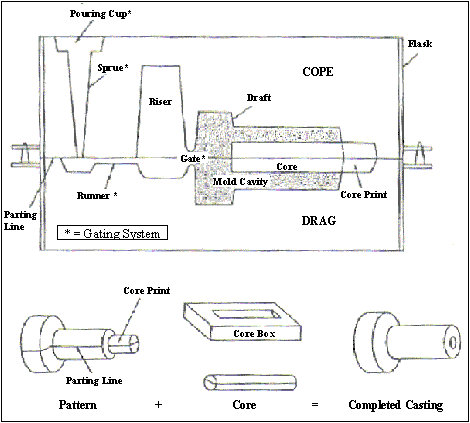Shop FoundryDISCLAIMER: I am not a professional! If you do this you will likely die, so click here now: www.disneyland.com I got started casting because I was building an aluminum
submarine and I needed
parts that I could not afford, however I had an abundance of scrap
aluminum laying around. I did not realize how rewarding it would
pour molten metal and turn it into something useful.
FoundryFoundries range greatly in complexity. On the low tech end you can dig a hole in ground, build a charcoal fire and fan it with billows. One the high tech end your foundry can use thermostatically controlled electric heat with electric host and gantry to lift move the crucible.
My foundries, like most hobby foundries are in the middle. I have a small flower pot furnace that can quickly melt 3 pounds of aluminum, and bigger 15 pound aluminum furnace that uses an inexpensive steel crucible and a big high temperature furnace for casting 30 pounds of brass or cast iron. The aluminum furnaces are both built using Mizzou Castable Refractory which has held up for for years and both are heated with propane. The large brass furnace is build from 3100 F castable refactory, creamic cloth, and is heated with propane to start and then switches to waste oil once it warms up. Read more about building each of these foundries here: Casting Furnaces
Terminology
Hot Wire Foam Cutter
Lost Foam Casting should be ideal for my needs so I when ahead and built a hot wire cutter that can be fitted to my old Craftsman table saw. There is no easier way to accurately cut foam and all you need is a simple frame, transformer, dimmer switch, and steel wire. Read more about it here: Hot Wire Cutter
|
|
Lost foam casting is by far the easiest way I have found to make one of a kind or small batch aluminum castings.
The 1/2 in thick gearbox in the photo was cast using lost foam. Ordinary house insulation foam was sliced into sheets then cut into the various shapes and hot glued together. The foam part was then coated with sheetrock mud and allowed to dry several times, until it was encased in a 1/2 layer of dried mud. Acetone was then poured into the opening on the top to dissolve the foam inside. The mud shell was then fired in a temporary kiln where it turned into a hard porcelain coat. Finally molten aluminum was poured in to fill the void.
Quick and simple foam castings can be make by simply placing the foam part in sand and pouring in the molten aluminum.
I made lots of mistakes along the way and I hope that you can lean from those too.
Read more about it here: Lost
Foam Casting
Lost Wax Casting
Lost wax casting is very much like lost foam casting. The difference is that a model of the part is made out of wax instead of foam. The advantage of wax over foam is that you can make a mold from wood, foam, plaster, or best RTV silicone and use that mold to make hundreds of the wax parts.
|
If you have a part that you want to copy, you can first cast it in RTV silicone and then use the RTV silicone mold to cast the wax parts.
You can also use machine wax that is worked into a model of the part using a lathe and or milling machine. When you have a good model of the part you can then choose to cast the part using the lost wax process instead of machine the part from stock aluminum.
Read more about it here: Lost Wax Casting
Sand Casting
|
There are more tools and materials needed for sand casting, but if you already have a part and you need a couple of duplicates then sand casting may be the best approach.
The only condition is that the part must be something that can be split in half and pulled out of the sand without messing up the impression left in the sand.
Read more about it here: Sand Casting
Aluminum Molds
|
In some cases you can successfully use aluminum as a mold for casting aluminum. But there are defiantly some cases were it will not work. I can show you both. :)
Read more about it here: Aluminum Molds
Foundry Suppliers
smallfoundrysupply.com
Small Foundry Supply - Flux
www.lmine.com Legend
- Crucibles
www.patriot-supply.com
Patriot-Supply - Oil burner nozzle part number: 30609-8 and adapter
part number: 17147
mifco.com Thermocouple Item #
004041
Foundry Forums
www.alloyavenue.com
founddreaming.com/forum
http://groups.yahoo.com/group/hobbicast
www.mifco.com
|
